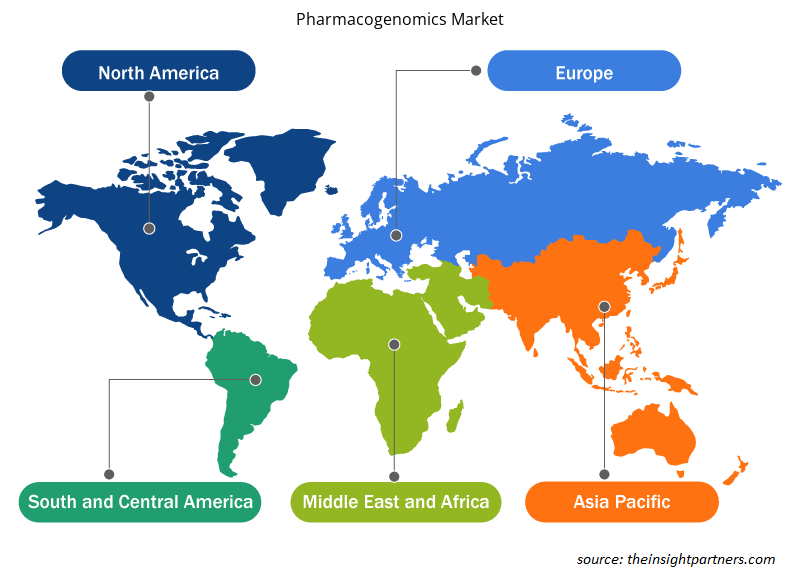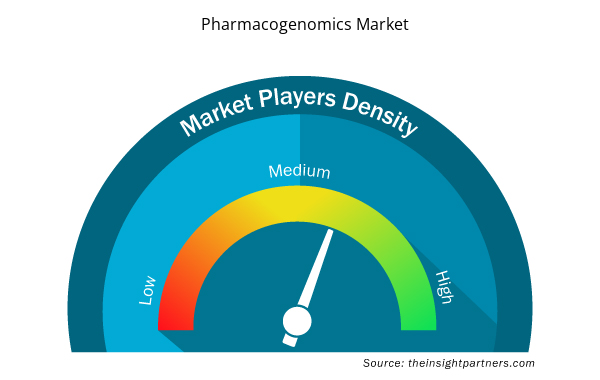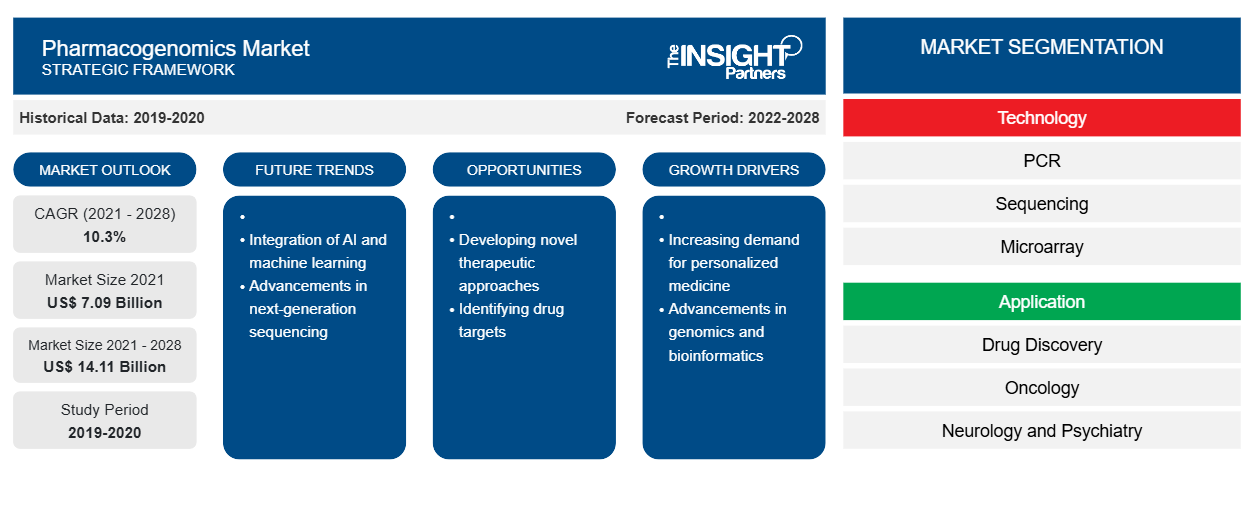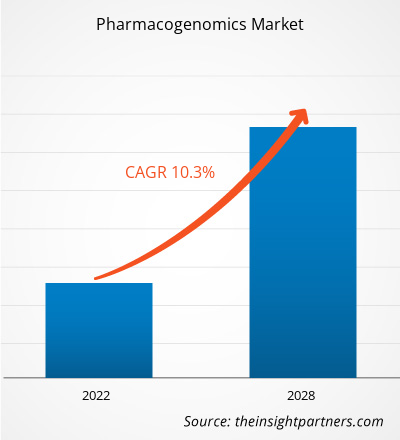من المتوقع أن يصل سوق الصيدلة الجينومية إلى 14،107.80 مليون دولار أمريكي بحلول عام 2028 من 7،087.81 مليون دولار أمريكي في عام 2021؛ ومن المتوقع أن ينمو بمعدل نمو سنوي مركب قدره 10.3٪ من عام 2021 إلى عام 2028.
إن الانتشار المتزايد للأمراض المزمنة هو أحد أهم العوامل التي تدفع نمو السوق. يعاني العديد من كبار السن (>60٪) من حالتين مزمنتين أو أكثر. ذكرت دراسات التوأم أن الجينات يمكن أن تسبب حالات مزمنة، مثل أمراض القلب والأوعية الدموية (CVDs)، والسكري، والسمنة، والتهاب المفاصل الروماتويدي، ومرض الزهايمر (AD)، والاكتئاب . باستخدام البيانات الوراثية الجزيئية من دراسات ارتباط الجينوم على نطاق واسع (GWAS)، أصبح من الممكن الآن قياس المخاطر على مستوى الفرد لهذه الأمراض المزمنة. وفقًا لمراكز السيطرة على الأمراض والوقاية منها (CDC)، في عام 2020، عانى ما يقرب من 6 من كل 10 أشخاص في الولايات المتحدة من مرض مزمن واحد على الأقل، وكان 4 من كل 10 أشخاص يعانون من حالتين مزمنتين أو أكثر. إن تزايد معدل الإصابة بالأمراض المزمنة يؤدي إلى زيادة الطلب على تقنيات الصيدلة الجينية لتطوير علاجات جديدة.
قم بتخصيص هذا التقرير ليناسب متطلباتك
ستحصل على تخصيص لأي تقرير - مجانًا - بما في ذلك أجزاء من هذا التقرير، أو تحليل على مستوى الدولة، وحزمة بيانات Excel، بالإضافة إلى الاستفادة من العروض والخصومات الرائعة للشركات الناشئة والجامعات
- احصل على أهم اتجاهات السوق الرئيسية لهذا التقرير.ستتضمن هذه العينة المجانية تحليلاً للبيانات، بدءًا من اتجاهات السوق وحتى التقديرات والتوقعات.
من المرجح أن تهيمن أمريكا الشمالية على سوق الصيدلة الجينومية خلال الفترة 2021-2028. تمتلك الولايات المتحدة أكبر حصة من السوق في أمريكا الشمالية ومن المتوقع أن تستمر في هذا الاتجاه خلال فترة التنبؤ. من المتوقع أن ينمو سوق الصيدلة الجينومية في الولايات المتحدة في السنوات القادمة بسبب الأنشطة البحثية المتزايدة لتطوير الطب الدقيق لعلاج السرطان، والوجود المتزايد لشركات الأدوية الحيوية والصيدلانية الرائدة، ونمو البحث الدوائي الجينومي في البلاد. يرتفع معدل تبني علاج السرطان القائم على الصيدلة الجينومية باستمرار، ويقدم اللاعبون الرائدون في السوق العديد من المنتجات الجديدة المرتبطة بهذا النهج. كما من المتوقع أن يدفع دعم الهيئات التنظيمية السوق في الولايات المتحدة خلال فترة التنبؤ. حاليًا، تقوم العديد من التجارب السريرية بالتحقيق في تكنولوجيا الصيدلة الجينومية لتطوير أدوية دقيقة وتحسين معدل الاستجابة الإجمالي للعلاج. في مايو 2021، وافقت إدارة الغذاء والدواء الأمريكية (FDA) على Lumakras (Sotorasib) لعلاج مرضى سرطان الرئة ذو الخلايا غير الصغيرة الذين يعانون من أورام تعبر عن طفرة G12C في جين KRAS.
رؤى السوق
التمويل المتزايد لأبحاث الصيدلة الجينية يدفع نمو السوق
إن تسلسل الجينوم يستخدم بشكل متزايد في الممارسة السريرية، ومن المتوقع أن يتم خلال السنوات الخمس المقبلة توليد بيانات جينومية لأكثر من 60 مليون مريض داخل نظام الرعاية الصحية. ويتحول علم الصيدلة الجينية بسرعة إلى الممارسة السريرية، ويبلغ إجمالي تنفيذه في أنظمة الرعاية الصحية المدعومة بالاستثمارات الحكومية أكثر من 4 مليارات دولار أمريكي في 14 دولة على الأقل.
أعلنت المملكة المتحدة عن أكبر مشروع جينوم في العالم كجزء من تعاون بين القطاعين العام والخاص بقيمة 200 مليون يورو بين الجمعيات الخيرية وشركات الأدوية. وقد طورت البلاد بالفعل أكبر قاعدة بيانات جينوم في العالم من خلال 100 ألف مشروع جينوم بقيادة Innovate UK كجزء من البحث والابتكار في المملكة المتحدة. سيمول المشروع الباحثين والصناعات للجمع بين البيانات والأدلة الواقعية من خدمات الرعاية الصحية في المملكة المتحدة وإنشاء منتجات وخدمات جديدة يمكنها تشخيص الأمراض بكفاءة.
علاوة على ذلك، أعلنت شركة بوسطن ساينتيفيك كوربوريشن، ومقرها ماساتشوستس، في أغسطس 2018 أنها حصلت على 4.3 مليون دولار أمريكي في تمويل أولي ودخلت في شراكة مع شركة فيريتاس جينيتكس. وستدعم الأموال مهمة الشركة في دخول عصر تسلسل الجينوم الشخصي من خلال إنشاء سوق موثوقة وآمنة ولامركزية للبيانات الجينومية.
رؤى مبنية على التكنولوجيا
بناءً على التكنولوجيا، يتم تقسيم سوق علم الصيدلة الجينية إلى تفاعل البوليميراز المتسلسل، والتسلسل، والمصفوفات الدقيقة، والرحلان الكهربائي للهلام، ومطياف الكتلة ، وغيرها. يتم تقسيم سوق شريحة تفاعل البوليميراز المتسلسل إلى تفاعل البوليميراز المتسلسل القياسي، وتفاعل البوليميراز المتسلسل في الوقت الفعلي، وتفاعل البوليميراز المتسلسل الرقمي. من المتوقع أن يشكل قطاع تفاعل البوليميراز المتسلسل الحصة الأكبر من سوق علم الصيدلة الجينية خلال الفترة 2021-2028. تفاعل البوليميراز المتسلسل هو تقنية مستخدمة بشكل شائع لإنتاج ملايين إلى مليارات النسخ من عينة DNA محددة بسرعة، مما يسمح للعلماء بأخذ عينة صغيرة من الحمض النووي وتضخيمها إلى كمية كبيرة بما يكفي للتحقيق بالتفصيل. تلعب تقنيات تفاعل البوليميراز المتسلسل دورًا رئيسيًا في استنساخ الجينات والتلاعب بها، واستنساخ الحمض النووي، وطفرة الجينات، والتحليل الوظيفي للجين، واكتشاف مسببات الأمراض، واختبار مقاومة الأدوية. تقدم العديد من شركات الأدوية والأدوية الحيوية حلول تفاعل البوليميراز المتسلسل لتطبيقات علم الصيدلة الجيني وتطوير الأدوية. على سبيل المثال، تقدم شركة Thermo Fisher Scientific, Inc حلول تفاعل البوليميراز المتسلسل في الوقت الفعلي للتطبيق الدوائي الجيني.
رؤى مبنية على التطبيق
بناءً على التطبيق، يتم تقسيم سوق علم الصيدلة الجينية إلى اكتشاف الأدوية، وعلم الأورام، وعلم الأعصاب والطب النفسي، وإدارة الألم، وأمراض القلب والأوعية الدموية، وغيرها. يتمتع قطاع علم الأورام بحصة سوقية كبيرة ومن المتوقع أن يستمر في هيمنته خلال فترة التنبؤ. ساهمت علم الصيدلة الجينية للسرطان في العديد من الاكتشافات الأساسية لعلاج السرطان الحالي، مما أدى إلى تغيير نموذج قرارات العلاج. ذكرت منظمة الصحة العالمية أن السرطان تسبب في حوالي 10 ملايين حالة وفاة في عام 2020. وعلاوة على ذلك، وفقًا لبيانات الجمعية الأمريكية للسرطان، من المتوقع أن يرتفع العبء العالمي للسرطان إلى 27.5 مليون حالة جديدة و16.3 مليون حالة وفاة بالسرطان بحلول عام 2040. تشير هذه الأرقام المرتفعة إلى أن ارتفاع معدل الإصابة بالسرطان يخلق متطلبًا للتشخيص البدائي والعلاج الوقائي. هناك العديد من الطرق، مثل تفاعل البوليميراز المتسلسل، واختبار INAAT، وتسلسل الجيل التالي، لتشخيص السرطان. لقد أدى مفهوم تفاعل البوليميراز المتسلسل إلى تقدم هائل في الاختبارات السريرية للحمض النووي. تتطلب الطرق القائمة على تفاعل البوليميراز المتسلسل أجهزة وبنية أساسية بسيطة، وتستغل كميات ضئيلة فقط من المواد البيولوجية، وهي متناغمة إلى حد كبير مع الروتين السريري. إن تطبيق علم الصيدلة الجينية في علم الأورام مهم بسبب المؤشر العلاجي المتناقص للأدوية الكيميائية وخطر الآثار الجانبية المهددة للحياة.
رؤى تعتمد على المستخدم النهائي
بناءً على المستخدم النهائي، يتم تقسيم سوق علم الصيدلة الجينية إلى المستشفيات والعيادات، وشركات الأدوية الحيوية، ومنظمات البحث التعاقدي ومنظمات التصنيع والتطوير، وغيرها. تتمتع شريحة منظمات البحث التعاقدي ومنظمات التصنيع والتطوير بحصة سوقية كبيرة ومن المتوقع أن تستمر في هيمنتها خلال فترة التنبؤ. تساعد منظمة البحث التعاقدي (CRO) العديد من الشركات والمنظمات من خلال إجراء التجارب السريرية لمنتجاتها وتقنياتها المتطورة، في حين تساعد منظمات التطوير والتصنيع التعاقدية (CDMO) الشركات في تطوير وتصنيع المنتجات. تقدم منظمات البحث التعاقدي خدمات، مثل إدارة المشاريع وتصميم وبناء قاعدة البيانات وإدخال البيانات والتحقق منها وإدارة بيانات التجارب السريرية وترميز الأدوية والأمراض وإعداد تقارير الجودة والقياس وخطط وتقارير التحليل الإحصائي وبرمجة التحقق وملخصات السلامة والفعالية وتقارير الدراسة النهائية. تقدم منظمات البحث التعاقدي أيضًا بعض الخدمات الأخرى مثل خدمات الجينات وخدمات الاستنساخ والتعبير.
تتبنى الشركات العاملة في سوق الصيدلة الجينومية استراتيجية النمو غير العضوي لتلبية متطلبات العملاء المتطورة في جميع أنحاء العالم، والتي تنطوي على عمليات الاستحواذ والاندماج والتعاون مع اللاعبين المحليين والدوليين في السوق العالمية.
رؤى إقليمية حول سوق الصيدلة الجينية
لقد قام المحللون في Insight Partners بشرح الاتجاهات والعوامل الإقليمية المؤثرة على سوق الجينوم الدوائي طوال فترة التوقعات بشكل شامل. يناقش هذا القسم أيضًا قطاعات سوق الجينوم الدوائي والجغرافيا في جميع أنحاء أمريكا الشمالية وأوروبا ومنطقة آسيا والمحيط الهادئ والشرق الأوسط وأفريقيا وأمريكا الجنوبية والوسطى.

- احصل على البيانات الإقليمية المحددة لسوق الصيدلة الجينومية
نطاق تقرير سوق الصيدلة الجينومية
| سمة التقرير | تفاصيل |
|---|---|
| حجم السوق في عام 2021 | 7.09 مليار دولار أمريكي |
| حجم السوق بحلول عام 2028 | 14.11 مليار دولار أمريكي |
| معدل النمو السنوي المركب العالمي (2021 - 2028) | 10.3% |
| البيانات التاريخية | 2019-2020 |
| فترة التنبؤ | 2022-2028 |
| القطاعات المغطاة | حسب التكنولوجيا
|
| المناطق والدول المغطاة | أمريكا الشمالية
|
| قادة السوق وملفات تعريف الشركات الرئيسية |
|
كثافة اللاعبين في سوق الصيدلة الجينومية: فهم تأثيرها على ديناميكيات الأعمال
يشهد سوق الصيدلة الجينومية نموًا سريعًا، مدفوعًا بالطلب المتزايد من المستخدم النهائي بسبب عوامل مثل تفضيلات المستهلك المتطورة والتقدم التكنولوجي والوعي المتزايد بفوائد المنتج. ومع ارتفاع الطلب، تعمل الشركات على توسيع عروضها والابتكار لتلبية احتياجات المستهلكين والاستفادة من الاتجاهات الناشئة، مما يؤدي إلى زيادة نمو السوق.
تشير كثافة اللاعبين في السوق إلى توزيع الشركات أو المؤسسات العاملة في سوق أو صناعة معينة. وهي تشير إلى عدد المنافسين (اللاعبين في السوق) الموجودين في مساحة سوق معينة نسبة إلى حجمها أو قيمتها السوقية الإجمالية.
الشركات الرئيسية العاملة في سوق الصيدلة الجينومية هي:
- شركة ف. هوفمان لاروش المحدودة
- أبوت
- أكسفورد نانوبور تكنولوجيز
- شركة ثيرمو فيشر العلمية
- شركة إيلومينا
إخلاء المسؤولية : الشركات المذكورة أعلاه ليست مرتبة بأي ترتيب معين.

- احصل على نظرة عامة على أهم اللاعبين الرئيسيين في سوق علم الصيدلة الجينية
سوق الصيدلة الجينية – التجزئة
- استنادًا إلى التكنولوجيا، يتم تقسيم سوق علم الصيدلة الجينية إلى تفاعل البوليميراز المتسلسل، والتسلسل، والمصفوفات الدقيقة، والرحلان الكهربائي للهلام، ومطياف الكتلة، وغيرها. يتم تقسيم سوق شريحة تفاعل البوليميراز المتسلسل إلى تفاعل البوليميراز المتسلسل القياسي، وتفاعل البوليميراز المتسلسل في الوقت الفعلي، وتفاعل البوليميراز المتسلسل الرقمي.
- من حيث التطبيق، يتم تقسيم سوق الصيدلة الجينية إلى اكتشاف الأدوية، وعلم الأورام، وعلم الأعصاب والطب النفسي، وإدارة الألم، وأمراض القلب والأوعية الدموية، وغيرها.
- بناءً على المستخدم النهائي، يتم تقسيم سوق الصيدلة الجينية إلى المستشفيات والعيادات والشركات الصيدلانية الحيوية ومنظمات البحث التعاقدية ومنظمات التصنيع الدوائي وغيرها.
- من حيث الجغرافيا، يتم تقسيم سوق الحقن داخل الجلد إلى أمريكا الشمالية (الولايات المتحدة وكندا والمكسيك)، وأوروبا (فرنسا وألمانيا وإيطاليا والمملكة المتحدة وإسبانيا وبقية أوروبا)، وآسيا والمحيط الهادئ (أستراليا والصين والهند واليابان وكوريا الجنوبية وبقية دول آسيا والمحيط الهادئ)، والشرق الأوسط وأفريقيا (المملكة العربية السعودية وجنوب أفريقيا والإمارات العربية المتحدة وبقية دول الشرق الأوسط وأفريقيا)، وأمريكا الجنوبية والوسطى (البرازيل والأرجنتين وبقية دول SCAM).
F. Hoffmann-la Roche Ltd؛ Abbott؛ Oxford Nanopore Technologies؛ Thermo Fisher Scientific Inc؛ Illumina, Inc؛ QIAGEN؛ Agilent Technologies, Inc؛ Myriad Genetics, Inc؛ Admera Health؛ وDynamic DNA Laboratories هي بعض الشركات التي تعمل في سوق الأدوية الجينية.
- التحليل التاريخي (سنتان)، السنة الأساسية، التوقعات (7 سنوات) مع معدل النمو السنوي المركب
- تحليل PEST و SWOT
- حجم السوق والقيمة / الحجم - عالميًا وإقليميًا وقطريًا
- الصناعة والمنافسة
- مجموعة بيانات Excel



Report Coverage
Revenue forecast, Company Analysis, Industry landscape, Growth factors, and Trends

Segment Covered
This text is related
to segments covered.

Regional Scope
North America, Europe, Asia Pacific, Middle East & Africa, South & Central America

Country Scope
This text is related
to country scope.
الأسئلة الشائعة
The global pharmacogenomics market based on technology is segmented into sequencing, PCR, gel electrophoresis, mass spectrometry, microarray, and others. In 2021, the PCR segment held the largest share of the market by technology and it is expected to witness fastest CAGR during 2021 to 2028, due to increasing utilization of this technology at global level.
The global pharmacogenomics market is segmented into North America, Europe, Asia Pacific, Middle East & Africa, and South & Central America. The North American area holds the largest market for pharmacogenomics. The United States held the most significant pharmacogenomics market and is expected to grow due to factors such as the increasing prevalence of chronic diseases and growing investments while the technological advancements by key players in pharmacogenomics is also boosting the growth rate in US.
The Asia Pacific region is expected to account for the fastest growth in the pharmacogenomics market. In Japan, India and South Korea, the market is expected to grow owing to the rapid development of research organizations and biopharmaceutical companies.
Several factors are believed to affect pharmacogenomics market in the coming years. Factors such as growing adoption of personalized therapies, increasing prevalence of chronic diseases, and growing funding in this sector are driving the market growth. However, lack of skilled professionals is likely to hamper the growth of the market.
The pharmacogenomics market majorly consists of the players such as F. Hoffmann-la Roche Ltd; Abbott; Oxford Nanopore Technologies; Thermo Fisher Scientific Inc.; Illumina, Inc.; QIAGEN; Agilent Technologies, Inc.; Myriad Genetics, Inc.; Admera Health; Dynamic DNA Laboratories among others..
Pharmacogenomics is a branch of science, which studies the role of gene over the activity of a drugs and hence helps the refreshers in predicting the response of novel as well as previously available therapies. Pharmacogenomics has direct application in the development of personalized medicine by testing single or multiple genes that are related to the disease. The main aim of this technology is to reduce the occurrence of treatment related adverse events and reduction in overall cost of treatment. The growing cases of ADRs and increasing demand of personalized therapies are expected to trigger the growth rate of this segment.
Trends and growth analysis reports related to Life Sciences : READ MORE..
The List of Companies - Pharmacogenomics Market
- F. Hoffmann-la Roche Ltd
- Abbott
- Oxford Nanopore Technologies
- Thermo Fisher Scientific Inc.
- Illumina, Inc.
- QIAGEN
- Agilent Technologies, Inc.
- Myriad Genetics, Inc.
- Admera Health
- Dynamic DNA Laboratories
The Insight Partners performs research in 4 major stages: Data Collection & Secondary Research, Primary Research, Data Analysis and Data Triangulation & Final Review.
- Data Collection and Secondary Research:
As a market research and consulting firm operating from a decade, we have published and advised several client across the globe. First step for any study will start with an assessment of currently available data and insights from existing reports. Further, historical and current market information is collected from Investor Presentations, Annual Reports, SEC Filings, etc., and other information related to company’s performance and market positioning are gathered from Paid Databases (Factiva, Hoovers, and Reuters) and various other publications available in public domain.
Several associations trade associates, technical forums, institutes, societies and organization are accessed to gain technical as well as market related insights through their publications such as research papers, blogs and press releases related to the studies are referred to get cues about the market. Further, white papers, journals, magazines, and other news articles published in last 3 years are scrutinized and analyzed to understand the current market trends.
- Primary Research:
The primarily interview analysis comprise of data obtained from industry participants interview and answers to survey questions gathered by in-house primary team.
For primary research, interviews are conducted with industry experts/CEOs/Marketing Managers/VPs/Subject Matter Experts from both demand and supply side to get a 360-degree view of the market. The primary team conducts several interviews based on the complexity of the markets to understand the various market trends and dynamics which makes research more credible and precise.
A typical research interview fulfils the following functions:
- Provides first-hand information on the market size, market trends, growth trends, competitive landscape, and outlook
- Validates and strengthens in-house secondary research findings
- Develops the analysis team’s expertise and market understanding
Primary research involves email interactions and telephone interviews for each market, category, segment, and sub-segment across geographies. The participants who typically take part in such a process include, but are not limited to:
- Industry participants: VPs, business development managers, market intelligence managers and national sales managers
- Outside experts: Valuation experts, research analysts and key opinion leaders specializing in the electronics and semiconductor industry.
Below is the breakup of our primary respondents by company, designation, and region:

Once we receive the confirmation from primary research sources or primary respondents, we finalize the base year market estimation and forecast the data as per the macroeconomic and microeconomic factors assessed during data collection.
- Data Analysis:
Once data is validated through both secondary as well as primary respondents, we finalize the market estimations by hypothesis formulation and factor analysis at regional and country level.
- Macro-Economic Factor Analysis:
We analyse macroeconomic indicators such the gross domestic product (GDP), increase in the demand for goods and services across industries, technological advancement, regional economic growth, governmental policies, the influence of COVID-19, PEST analysis, and other aspects. This analysis aids in setting benchmarks for various nations/regions and approximating market splits. Additionally, the general trend of the aforementioned components aid in determining the market's development possibilities.
- Country Level Data:
Various factors that are especially aligned to the country are taken into account to determine the market size for a certain area and country, including the presence of vendors, such as headquarters and offices, the country's GDP, demand patterns, and industry growth. To comprehend the market dynamics for the nation, a number of growth variables, inhibitors, application areas, and current market trends are researched. The aforementioned elements aid in determining the country's overall market's growth potential.
- Company Profile:
The “Table of Contents” is formulated by listing and analyzing more than 25 - 30 companies operating in the market ecosystem across geographies. However, we profile only 10 companies as a standard practice in our syndicate reports. These 10 companies comprise leading, emerging, and regional players. Nonetheless, our analysis is not restricted to the 10 listed companies, we also analyze other companies present in the market to develop a holistic view and understand the prevailing trends. The “Company Profiles” section in the report covers key facts, business description, products & services, financial information, SWOT analysis, and key developments. The financial information presented is extracted from the annual reports and official documents of the publicly listed companies. Upon collecting the information for the sections of respective companies, we verify them via various primary sources and then compile the data in respective company profiles. The company level information helps us in deriving the base number as well as in forecasting the market size.
- Developing Base Number:
Aggregation of sales statistics (2020-2022) and macro-economic factor, and other secondary and primary research insights are utilized to arrive at base number and related market shares for 2022. The data gaps are identified in this step and relevant market data is analyzed, collected from paid primary interviews or databases. On finalizing the base year market size, forecasts are developed on the basis of macro-economic, industry and market growth factors and company level analysis.
- Data Triangulation and Final Review:
The market findings and base year market size calculations are validated from supply as well as demand side. Demand side validations are based on macro-economic factor analysis and benchmarks for respective regions and countries. In case of supply side validations, revenues of major companies are estimated (in case not available) based on industry benchmark, approximate number of employees, product portfolio, and primary interviews revenues are gathered. Further revenue from target product/service segment is assessed to avoid overshooting of market statistics. In case of heavy deviations between supply and demand side values, all thes steps are repeated to achieve synchronization.
We follow an iterative model, wherein we share our research findings with Subject Matter Experts (SME’s) and Key Opinion Leaders (KOLs) until consensus view of the market is not formulated – this model negates any drastic deviation in the opinions of experts. Only validated and universally acceptable research findings are quoted in our reports.
We have important check points that we use to validate our research findings – which we call – data triangulation, where we validate the information, we generate from secondary sources with primary interviews and then we re-validate with our internal data bases and Subject matter experts. This comprehensive model enables us to deliver high quality, reliable data in shortest possible time.


 احصل على عينة مجانية لهذا التقرير
احصل على عينة مجانية لهذا التقرير